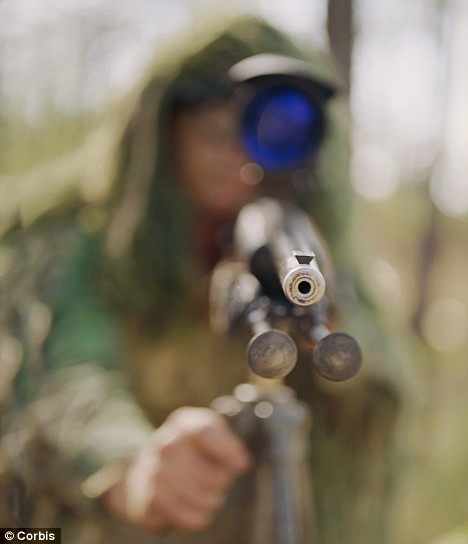The 'cat's eyes' laser that can help British troops pinpoint a sniper before he pulls the trigger
By Mail Foreign Service
Last updated at 11:34 PM on 12th January 2009Snipers or assassins could be spotted in their nests before even firing a shot thanks to laser surveillance technology to be unveiled in Britain.
European and U.S. companies are accelerating research into anti-sniper defences in response to threats in Afghanistan and Iraq and at home.
But most systems use acoustic or thermal sensors that depend on waiting for the first shot.

Laser protection: The anti-sniper defences, unlike thermal and acoustic sensors, could allow troops to spot assassins in their nests before firing a shot
An alternative developed by the European aerospace group EADS aims to warn of attack and pinpoint the sniper before he pulls the trigger by bouncing light off his telescopic sight.
'It is the same principle as 'cat's eyes' in the middle of the road,' said Peter Talbot-Jones, research team leader at EADS Innovation Works at Newport in Wales.
'Cat's eyes' behave like the retina of a cat by reflecting light from a car's headlamps to illuminate lines on the road.
Resembling a speed radar on a tripod, the ELLIPSE unit sweeps a protected zone with laser beams.
These are reflected back off any lens they hit.
A processor then distinguishes the signature of a sniper's sight from that of, say, a camera lens.
'We aim to use a sniper's technology against him,' said Mr Talbot-Jones, who served with British forces in Afghanistan, where ex-Soviet Dragunov sniper rifles are readily available.

The new technology works like 'cat's eyes' and will allow soldiers to quickly pinpoint a sniper, such as the one above in Iraq
If several machines are deployed around a dignitary at a political rally or in a sports stadium, the position of a sniper could be revealed as soon as the sight is spotted by 'triangulation', the technique used in GPS satellite navigation.
Harmless reflections from photographic lenses and binoculars would be identified and discarded, Mr Talbot-Jones said.
For years, detecting snipers depended on the type of sleuth work depicted in Hollywood thrillers - figuring out where a military marksman or lone wolf killer might try to hide. Only recently has technology begun to tip the balance.
Britain's QinetiQ recently launched a palm-sized device called EARS to locate sniper fire through acoustics.
EADS, which stumbled on its optical technique through anti-missile research, hopes to present its idea to the hosts of London's 2012 Olympics as a way of shielding dignitaries.
The civil threat from snipers revives sensitive memories of past assassinations such as that of U.S. President John F. Kennedy, a week before Barack Obama is due to be sworn in amid tight security as the first African American U.S. president.
Colorado police last year arrested three men and seized sniper equipment over a suspected plot to kill Obama, but later said they did not pose a serious threat.
The EADS project reflects defence firms' efforts to diversify into security amid pressure on military budgets.
Source: http://www.dailymail.co.uk/sciencetech/article-1113462/The-cats-eyes-laser-help-British-troops-pinpoint-sniper-pulls-trigger.html
